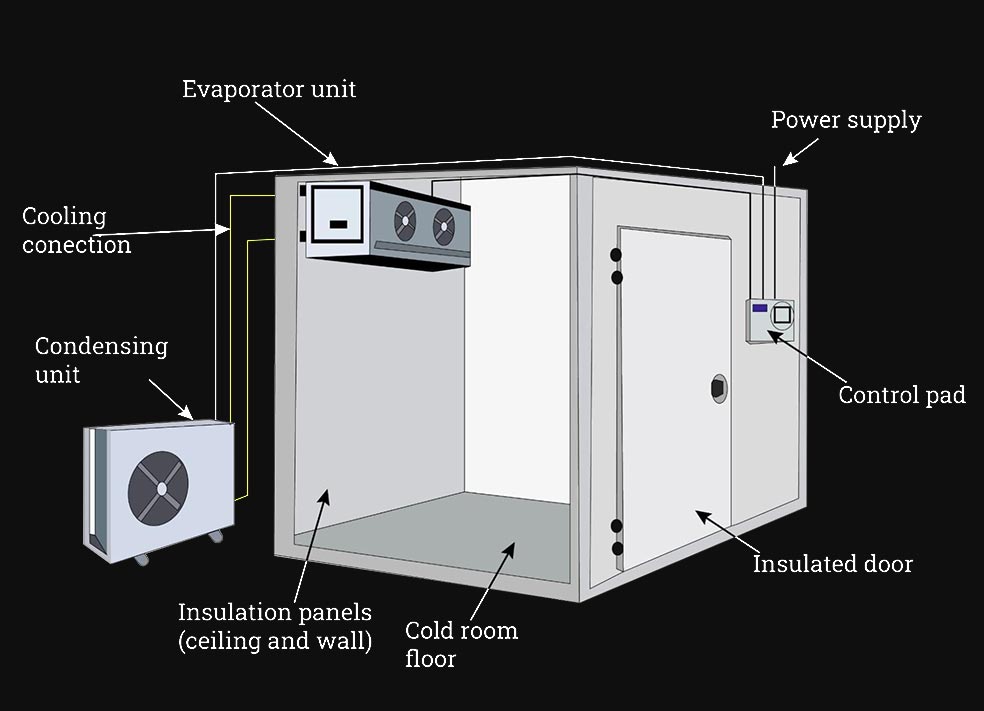Designing a cold room is a complex yet rewarding journey, bridging the gap between raw conceptual ideas and efficient, high-performing storage solutions. Whether used for food preservation, pharmaceuticals, or industrial applications, cold rooms must meet stringent temperature and hygiene standards, while optimizing space, energy efficiency, and workflow.
This article walks you through the cold room design journey – from the initial sketch to the final storage-ready facility, highlighting the key steps, considerations, and best practices involved.
1. Understanding the Purpose and Requirements
The journey begins with defining the cold room’s purpose. Different industries require specific conditions:
- Food Industry: Requires temperature zones for chilling or freezing meat, seafood, dairy, or produce.
- Pharmaceuticals: Must comply with strict storage regulations (like GDP or FDA) and maintain consistent temperature monitoring.
- Industrial Applications: May include chemical storage requiring controlled environments.
Key questions during this phase include:
- What temperature range is needed? (e.g., +2°C to +8°C for cool rooms, or -18°C and below for freezer rooms)
- What are the daily load cycles and stock turnover rates?
- Are any special regulations (e.g., HACCP, GMP, FDA) applicable?
Clear answers will guide the design towards functionality and compliance.
2. Site Assessment and Space Planning
Once the requirements are known, the next step is assessing the available space. This includes:
- Measuring dimensions (floor area, height, existing infrastructure)
- Checking insulation capability of surrounding structures
- Ensuring accessibility for loading/unloading
- Assessing utilities: electricity supply, drainage, ventilation
During this phase, designers consider:
- Floor load-bearing capacity
- Placement of evaporators and condensers
- Ease of access for both personnel and machinery
- Potential expansion options for future needs
Proper space planning helps avoid design flaws such as insufficient clearance or airflow obstructions.
3. Sketching the Initial Layout
Now comes the first visual representation – the initial sketch. Architects and engineers draft:
- Overall room layout with dimensions
- Equipment positions (evaporator units, doors, racking systems)
- Work zones and access paths
- Lighting, sensors, and drainage points
This phase often uses 2D CAD drawings and progresses to 3D modeling software to simulate the real space.
At this stage, early collaboration with refrigeration specialists is vital. For example, the cold room may require:
- Multiple temperature zones
- Redundant cooling systems
- Pre-cool or airlock areas to minimize heat transfer
4. Choosing the Right Materials and Components
Material selection is critical to ensure durability, hygiene, and thermal performance. Key elements include:
a. Insulation Panels
- Polyurethane (PU) panels: Common for high thermal resistance
- Polystyrene or PIR panels: Alternatives with different fire ratings and costs
Panels are chosen based on:
- Required insulation thickness
- Thermal conductivity (λ-value)
- Fire resistance and hygiene compliance
b. Doors
- Hinged doors: Ideal for small cold rooms
- Sliding doors: Space-saving for larger setups
- Automatic doors: Used in high-traffic facilities
Door seals, materials, and heaters (for freezers) must be considered.
c. Refrigeration Systems
Selecting the appropriate system guarantees efficient cooling and reduced energy consumption. Options include:
- Monoblock units (compact, easy to install)
- Split systems (flexible, for larger cold rooms)
- Centralized systems (for industrial-scale setups)
Refrigerant type, compressor capacity, and energy efficiency ratings must match the load requirements and environmental regulations.
5. Regulatory Compliance and Safety Integration
A well-designed cold room is not just about storage – it must also be safe and compliant. During this phase:
- Fire-resistant materials are integrated (e.g., PIR panels, certified doors)
- Emergency exits and safety alarms are planned
- Backup systems (such as generators or dual compressors) are considered
- Built-in temperature and humidity sensors provide continuous monitoring
- Compliance with standards like HACCP, FDA, BRC, or ISO 22000 is reviewed
Hygienic design features like rounded wall corners, sloped floors, and washable surfaces are incorporated to prevent contamination and ensure easy cleaning.
6. Prototype Modeling and Client Approval
Before construction begins, a detailed prototype (digital or scaled model) is created. This is shared with stakeholders for feedback and final approval. This step:
- Confirms that the layout aligns with operational workflow
- Helps avoid costly post-installation modifications
- Visualizes how equipment, racking, and personnel will interact
- Assesses energy usage and performance via simulation tools
Stakeholders may include warehouse managers, refrigeration engineers, hygiene auditors, and facility planners.
7. Installation and Construction
Once approved, the physical build begins. A well-coordinated installation includes:
- Floor Preparation: Leveling, vapor barriers, and insulation layers
- Panel Assembly: Wall and ceiling panels are interlocked and sealed
- Refrigeration Installation: Pipes, compressors, evaporators, and controllers are installed
- Electrical Work: Lighting, control panels, alarms, and automation systems
- Final Fittings: Doors, shelves, loading ramps, and protective bumpers
All construction must follow strict guidelines to avoid thermal leaks, condensation, or hygiene risks.
8. System Testing and Commissioning
After installation, the cold room is tested under real conditions:
- Temperature stability under load and during door openings
- Emergency systems (alarms, power backups)
- Sensor calibration and system responsiveness
- Airflow circulation and defrost cycles
This is often a multi-day process, involving engineers and quality inspectors to ensure operational readiness.
9. Training and Handover
The facility team receives training on:
- Operating controls and monitoring systems
- Performing basic maintenance tasks
- Identifying and reporting irregularities
- Emergency response procedures
A handover package is provided, including:
- As-built drawings
- Warranty certificates
- Maintenance schedule
- Compliance documentation
10. Storage and Operational Integration
With the cold room fully functional, it’s time to stock and integrate it into daily operations. Key tasks include:
- Setting stock rotation systems (FIFO or LIFO)
- Labeling temperature zones
- Monitoring performance with remote sensors
- Conducting routine maintenance and hygiene audits
Well-designed cold rooms contribute to:
- Reduced energy consumption
- Minimized product loss
- Enhanced operational efficiency
- Extended product shelf life

